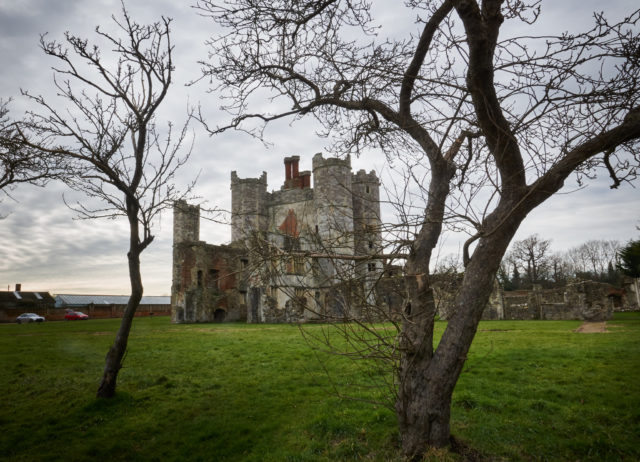Titchfield Abbey is located near the River Meon in Hampshire, England. The abbey was founded during the early part of the 13th century by the powerful Bishop of Winchester, Peter des Roches, who was a church leader and an influential politician.
The bishop built the abbey for the Premonstratensian canons. He endowed his new abbey not only with the manor of Titchfield but also other estates as well. In addition, nobles and even King Henry III provided their own grants and privileges to the new religious order.

Premonstratensian canons aren’t like monks who live in seclusion. Instead, these churchmen (also known as “white canons” due to the color of their robes) went out to preach and teach the gospel.
The white canons would also assist those parishes which were local to their abbey or priory. In fact, of the 14 or 15 canons who lived at Titchfield during the peak of its influence, two of them served as vicars in nearby parish churches.

The abbey was dedicated to St. Mary and St. John the Evangelist and possessed about 5,000 acres of land which included 11 estates and farms. There were also five fishponds which were recorded as being a mile long overall and home to about 100,000 fish.
Although this might seem impressive today, in its time, Titchfield was not considered particularly wealthy and the fact that there were only ever 14-15 canons in residence illustrates that it was quite small.

Instead, Titchfield Abbey was considered a place of learning and was quite renowned for its library which contained 224 volumes in Latin, English, and French. The catalog survives today and shows that the library held volumes on theology, medicine, history, and law, among many other subjects.
Its layout was pretty standard for a religious complex in that it included a chapter house, dormitories, a kitchen, the church with a bell tower, and the refectory. The buildings might not have been large but there is evidence that they were very fine and of good quality.

Due to its location between London and the English ports of Southampton and Portsmouth, the abbey soon became a popular stopping point for those who were making a trip to Europe. Henry V stopped there on his way to a military campaign in France.
Titchfield Abbey was even the venue for a royal wedding. On April 23, 1445, Henry VI and Margaret of Anjou celebrated their wedding in this abbey.

In the 1530s, Henry VIII began to dissolve all the monasteries in England. In 1535, the abbey managed to avoid the first wave of suppressions due to the fact that its income was quite modest.
However, Thomas Wriothesley wanted the land for himself and put pressure on the abbot to surrender the abbey voluntarily before he was forced to do so. Realizing what was coming, the abbot and canons began to sell their cattle, treasures, and church plate to secure themselves some funds. In December 1537, the abbey was officially dissolved.

This grand building was immediately transformed into a fortified manor and was named Place House. Thomas Wriothesley added battlements to his new home and turned some of the grand windows into impressive fireplaces with elaborate chimneys. There was also a small, private theater and deer park.
Wriothesley rebuilt many of the structures and added a large gatehouse across the nave. As a result of his renovations, only little bits of the original church can still be seen today, such as the foundations and part of a spiral staircase in the west corner turret.

Over the next few centuries, the former abbey of Titchfield turned from a place of worship into a venue for entertaining the nobility and monarchs. Records show that both Elizabeth I and Charles I stayed here during their lifetimes.
It is also believed that one or more of Shakespeare’s plays might have had its premiere performance here because the 3rd Earl of Southampton (Thomas Wriothesley’s grandson) was a patron of William Shakespeare.

Over time, the Earls spent more and more time at other residences they owned. After the death of the 4th Earl of Southampton, Place House was passed through several families until 1781, when the building was finally abandoned altogether.
Various parts of the building were demolished so that the stone could be used on other construction projects. This was not surprising as natural stone in the area was so hard to come by that the stone used to build the abbey in the first place had come from Dorset, the Isle of Wight, and even France.

Today, Titchfield Abbey is in the care of English Heritage. Much of the original structure was destroyed by the Wriothesley family, meaning that only some elements of the former monastery buildings are in evidence today.
Nevertheless, this place is open to the public and has hosted music festivals and open-air theater performances. It is even possible to fish in the ponds, which have been maintained to the present.

Archaeological excavations carried out in 1923 uncovered various elements of the former abbey, including the location of its library.
These excavations also revealed tiles had been hidden for 400 years, protected by the construction of the porch to the great hall in Tudor times. Tiles found outside the refectory (where the canons would go to eat) have an inscription in Latin which translates as: “Before you sit down to meat at your table first remember the poor.”

The photographs were taken by Andy Oldster and a big thank you to him for giving us an opportunity to view this historical site. You can find more of Andy’s beautiful and detailed photos of this place or many others on his Flickr account via this link.






Abandoned Soviet Airbase in Germany

